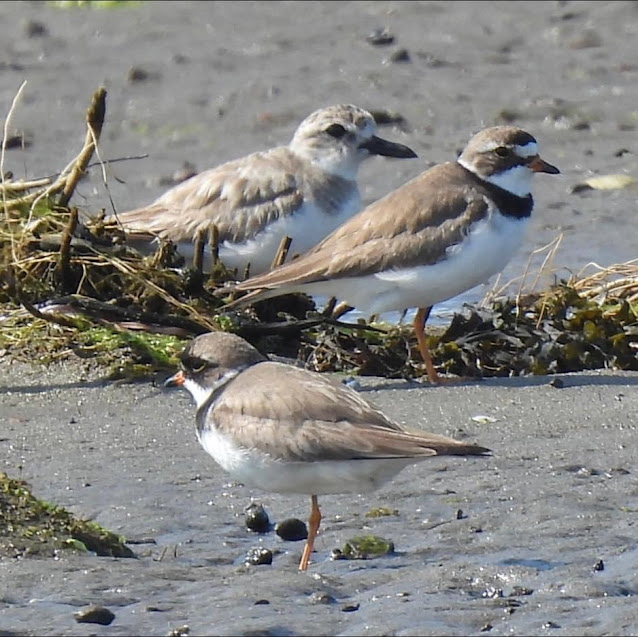Wilson's Plover Female [Photo by Marbeth Wilson]
On 23 July 2024 a birder discovered a very rare shorebird at Cormierville Marsh, off Route 535 in Westmorland County, a Wilson’s Plover (Anarhynchus wilsonia). This bird remains in approximately the same location at least until early August. It is associating with a flock of Semipalmated Plovers and peeps. Many birders and photographers have been fortunate to see it.
The arrival of this species to New Brunswick marks the first documented occurrence of this species here. Apparently it has been reported very rarely before but none was documented. This makes this a very exciting find and it is fortunate that many have shared its presence.
The normal range of the Wilson’s Plover is far from New Brunswick. It breeds on the Atlantic coast from southern Virginia to Belize, the West Indies, and on the northern coast of South America. In the west it breeds on the western coast of Mexico. It winters from northern Mexico, the Gulf coast and Florida south to northern South America. It is a permanent resident in some of these areas. It is a vagrant to parts of the western US (Oregon, Colorado, Oklahoma, Minnesota) and also to Ontario and Nova Scotia. Most northern birds are migratory moving northward in the spring from mid-February to April and southward in the fall from mid-July to mid-October.
The Wilson’s Plover is a bit bigger than the Semipalmated Plover ( 20 cm compared to 18 cm). Its shape, big bill and different plumage separate the two species. The Wilson’s Plover appears big-headed and longer legged. Technically the large bill, complete breast band and white collar identify the species. The black head markings on the crown identify the male. In the female brown replaces the black on the head. The legs are flesh-coloured. Nonbreeding birds look much like the female. Some show black on the breast band so they might look like the males. In a small percentage of individuals the breast band is incomplete. The juvenile looks like the nonbreeding bird but shows pale fringes on the feathers of the upper parts. It also sometimes shows an incomplete breast band. In flight all forms can be distinguished from the Semipalmated Plover by the large bill, whiter face, and the white wing stripe on the dorsal surface is weak on the inner wing. It is strong on the Semipalmated. All photos in this post appear to be of females or non breeding adults.
The Wilson’s Plover is a bird of the upper sandy beach. This species likes sparse coastal habitats including sandy beaches, sand dunes, salt flats, mud flats and coastal islands. It commonly roosts on the drier upper beach in small patches of vegetation or among driftwood and debris. It often forages on the upper beach away from most shorebirds but will also feed in the wet sand and muddy areas of the intertidal zone. It is usually seen feeding with other plovers and small shorebirds. Wilson’s Plovers tend to stick to the beach when disturbed. They would rather run than fly. They appear tame and will allow one to approach usually to 20 yards. They feed in a stop-and-go method like Semipalmated Plovers but they pause longer between sprints and they usually run further. They usually appear hunched up with their heads adducted but they can stand tall with their heads up and when they strike for food they reach forward rather than straight down like the Semipalmateds.
Wilson’s Plovers feed on many crustaceans including crabs, crayfish and shrimp. In South Carolina I have seen them feeding on fiddler crabs which are abundant. They also feed on small mollusks, marine worms and insects and their larvae.
Wilson’s Plovers nest as isolated pairs or in small loose colonies. The nest is a scraping in the sand on a drier part of the beach usually near a clump of grass or a piece of driftwood. The scrape is lined with small pieces of shell, pebbles, grass or debris. The male courts the female by performing ritualized nest scraping, posturing in front of her with drooping wings, tail held low and spread and by pattering his feet. The male thus makes several scrapes and the female chooses one. In the nest the female lays 2 or 3 buff eggs blotched with brown and black. Both adults incubate the eggs, the male at night and the female during the day. Incubation is for 23 to 25 days and the young leave the nest upon hatching. Both parents tend the young but they are precocious and feed themselves. They are flightless until about 21 days of age.
The Wilson’s Plover was named after the Scottish-American ornithologist Alexander Wilson in 1814. He collected the type specimen in May, 1813 at Cape May, N.J. where it was a rare visitor and remains so today. General population numbers today are listed as threatened or endangered in some states of the US. That is undoubtedly because of habitat loss. Perhaps that is why some individuals wander northward to Nova Scotia, Ontario and now New Brunswick. We may see more in the future.
The sighting of the Wilson's Plover was very special for one of our New Brunswick birders, Jim Wilson of Quispamsis. Bird lists are important to birders and one of our lists is the number of species seen in New Brunswick. For Jim Wilson this bird was his 400th species! That is a mark not made by any other NB birder. Congratulations, Jim, from all of us. It is also pretty neat that your 400th bird was a Wilson's Plover.




